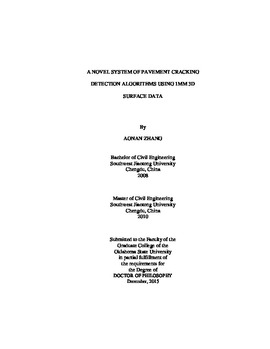| dc.contributor.advisor | Wang, Kelvin C. P. | |
| dc.contributor.author | Zhang, Aonan | |
| dc.date.accessioned | 2016-09-29T18:47:21Z | |
| dc.date.available | 2016-09-29T18:47:21Z | |
| dc.date.issued | 2015-12 | |
| dc.identifier.uri | https://hdl.handle.net/11244/45390 | |
| dc.description.abstract | Pavement cracking is one of the major concerns for pavement design and management. There have been rapid developments of automated pavement cracking detection in recent years. However, none of them has been widely accepted so far due to lack of capability of maintaining consistently high detection accuracy for various pavement surfaces. Using 1mm 3D data collected by WayLink Digital Highway Data Vehicle (DHDV), an entire system of algorithms, which consists of Fully Automated Cracking Detection Subsystem, Interactive Cracking Detection Subsystem and Noisy Pattern Detection Subsystem, is proposed in this study for improvements in adaptability, reliability and interactivity of pavement cracking detection. | |
| dc.description.abstract | The Fully Automated Cracking Detection Subsystem utilizes 3D Shadow Simulation to find lower areas in local neighborhood, and then eliminates noises by subsequent noise suppressing procedures. The assumption behind 3D Shadow Simulation is that local lower areas will be shadowed under light with a certain projection angle. According to the Precision-Recall Analysis on two real pavement segments, the fully automated subsystem can achieve a high level of Precision and Recall on both pavement segments. | |
| dc.description.abstract | The Interactive Cracking Detection Subsystem implements an interactive algorithm proposed in this study, which is capable of improving its detection accuracy by adjustments based on the operator's feedback, to provide a slower but more flexible as well as confident approach to pavement cracking detection. It is demonstrated in the case study that the interactive subsystem can retrieve almost 100 percent of cracks with nearly no noises. | |
| dc.description.abstract | The Noisy Pattern Detection Subsystem is proposed to exclude pavement joints and grooves from cracking detection so that false-positive errors on rigid pavements can be reduced significantly. This subsystem applies Support Vector Machines (SVM) to train the classifiers for the recognition of transverse groove, transverse joint, longitudinal groove and longitudinal joint respectively. Based on the trained classifiers, pattern extraction procedures are developed to find the exact locations of pavement joints and grooves. | |
| dc.description.abstract | Non-dominated Sorting Genetic Algorithm II (NSGA-II), which is one of multi objective genetic algorithms, is employed in this study to optimize parameters of the fully automated subsystem for the pursuing of high Precision and high Recall simultaneously. In addition to NSGA-II, an Auxiliary Prediction Model (APM) is proposed in this study to assist NSGA-II for faster convergence and better diversity. | |
| dc.description.abstract | Finally, CPU-based and GPU-based Parallel Computing Techniques, including MultiGPU, GPU streaming, Multi-Core and Multi-Threading are combined in this study to increase the processing speed for all computational tasks that can be synchronous. | |
| dc.format | application/pdf | |
| dc.language | en_US | |
| dc.rights | Copyright is held by the author who has granted the Oklahoma State University Library the non-exclusive right to share this material in its institutional repository. Contact Digital Library Services at lib-dls@okstate.edu or 405-744-9161 for the permission policy on the use, reproduction or distribution of this material. | |
| dc.title | Novel system of pavement cracking detection algorithms using 1mm 3D surface data | |
| dc.contributor.committeeMember | Cross, Stephen A. | |
| dc.contributor.committeeMember | Yang, Xiaoming | |
| dc.contributor.committeeMember | Yen, Gary G. | |
| osu.filename | Zhang_okstate_0664D_14294.pdf | |
| osu.accesstype | Open Access | |
| dc.type.genre | Dissertation | |
| dc.type.material | Text | |
| thesis.degree.discipline | Civil Engineering | |
| thesis.degree.grantor | Oklahoma State University | |
